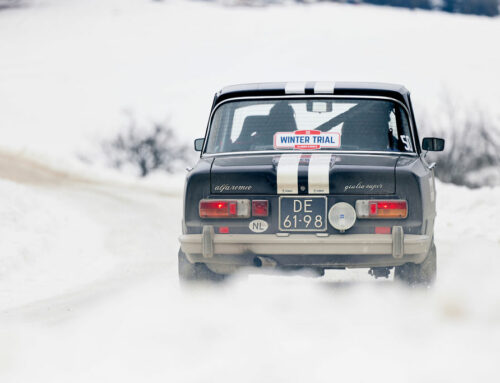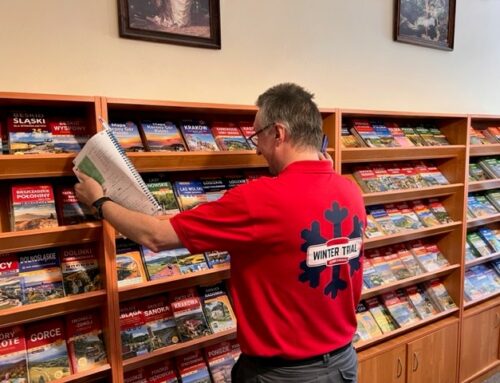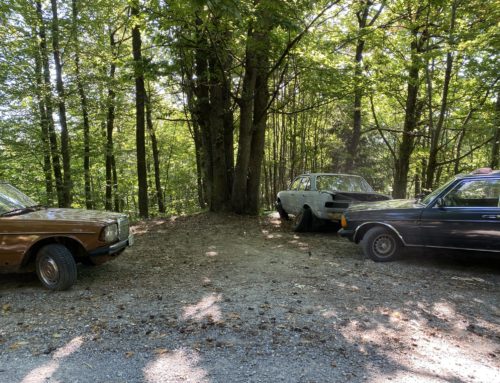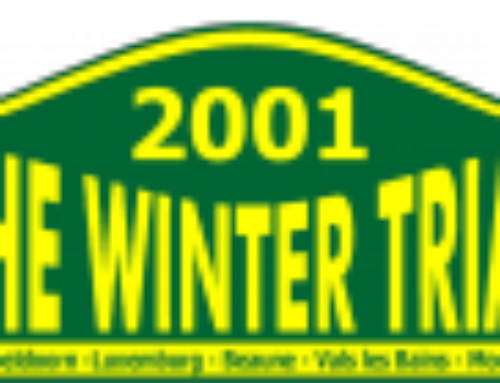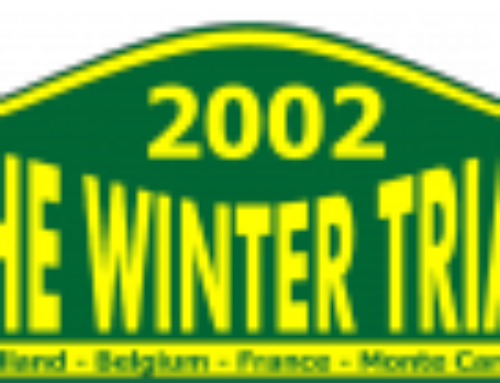The Winter Trial 2008
Prague, Brno, Olomouc, Nasavrky, Hradec Kralove, Karlovy Vary, Cesky Krumlov, Linz, St. Wolfgang
David Winstanly Reports
Photos Mike Johnson of Clicksport
The first round of the 2008 FIA Trophy for Regularity Rallies, the Winter Trial is regarded by most as the toughest event of the season with two enormously challenging night sections.
Organised by Classic Events of The Netherlands under the guidance of Bart Rietbergen, in its earlier days it finished in Monte Carlo, but the continuing lack of snow in the region in January and the difficulties encountered by all non-French events trying to compete in the region meant that the event has moved further and further towards Eastern Europe. For the first time the event started in Prague with a short first day’s run to Brno, before an anti-clockwise loop of the Czech Republic and the finish at the Austrian lakeside resort of
St. Wolfgang.
Unlike the Rally of the Tests and the Classic Marathon, theWinter Trial does allow Mk 1 Escorts, and it is the Mk1 that has won the event for the past three years – in 2005 with John Bateson and Fred Bent, and in 2006 and 2007 with Dutch crew Harm Lamberigts and Arthur Dentzler. The 107 car entry featured everything from a 1935 Bentley Derby to a 1976 Sunbeam Avenger, with 17 Volvos of various types being the most numerically popular as well as many Alfa Romeos and a whole batch of Porsche 911s, which could usually be seen driving in the wrong direction! The event is split into two categories: the full FIA event being called the Trial Route, because a Trial it certainly is; and there is a second, shorter, Club Route. This is generally slightly easier and misses out both night loops, but nevertheless is still a serious challenge for both driver and navigator running for six days, from Sunday to Friday, just as the Trial event does. Virtually the entire field of Club competitors was Dutch and many were novices, which meant that even the simplest of junctions was often a subject for much debate within the car. The first day of the rally was noticeable for the diabolical weather that saw freezing horizontal rain lashed by strong winds forcing itself into every sinew and the Vredestein tyres backed Service Crews with plenty to keep them occupied.Like all events of this type no competing car is allowed any back-up service, having to rely on the crew’s ownefforts to keep going, although they can accept help from other competitors and the event supplied service crew. As mentioned, the winners for the past two years were Harm Lamberigts and Arthur Dentzler in a Mk1 Escort, and after a first day of tests and regularities, it was they who held the lead again.With an enviable network of sponsors, early retirements find the blow of being out of the rally somewhat softened by the free loan of a Nissan Quasqai courtesy car. The event’s other sponsors ensure that all the competitors, marshals and press are treated as well as possible and in the most sociable manner.
It’s on the second day that this event generally gets tougher and this year was no exception. The the majority of theregularities and tests are the same for both the Club and the Trial crews and whilst this means that the experts might hope just to drop a few seconds here and there, for quite a number of the club entrants even finding the time controls along the road offers a significant challenge. Along the route from Brno to Olomouc the rally took a quick trip into Slovakia for a rather nice test at a tyre testing facility, and it was here that we were to see the pace of the Club route entered Porsche 911s. Those of Hank Melse and Wim Van Der Stratten were particularly impressive and absolutely flew. Also doing well in a Porsche was Gijs Van Lennep, the former Le Mans winner and some time Grand Prix driver. He was leading last year when he put his Porsche 356 into a ditch but at the end of the second day here he was lying fifth overall. Van Lennep is not without rally experience having competed in six Monte Carlo rallies in the late ‘70s and early ‘80s. It was towards the end of the day that the event saw its first real excitement, an icy uphill section on a regularity saw about 40 crews queued up behind each other. Some took the opportunity to fit chains and were rewarded with an easy uphill passage. Others didn’t and found themselves truly stuck. There was real bad luck here for German driver Reiner Seume, who only realised that he hadn’t put his hand brake on in his Lancia Fulvia when it rolled away from him and down into the woods where it remained until rescued by a local farmer. But worse off were rally leaders Harm Lamberigts and Arthur Dentzler who were out for good with a holed radiator after a road accident with a local.MPO Slot Online
The leaders at the start of day three were British crew Malcolm Pickering and Iain Tullie. FIA World Regularity Champions in 2006, this wonderfully consistent team was in one of the oldest of the Trial Class cars, Pickering’s self prepared 1960 Sunbeam Rapier, and the 70-year-old driver gets almost as much pleasure in preparing the car himself as he does from competing. Tullie is one of the UK’s most experienced road rally navigators and earns his living as a logistics co-ordinator for M-Sport, the company that runs the Ford WRC efforts. With all that experience the leaders had a fairly predictable day, and it was behind them that mistakes were being made. Fred Bent, winning navigator in 2005 and Clerk of the Course on the Rally of The Tests, doesn’t make too many mistakes, he saves them all up for big ones – and a five-minute penalty dropped him and his driver Peter Naaktgeboren from third at the start of the day to 11th at the end of it. Still that’s the joy of being a navigator because, as everybody knows, the driver wins the rally but the navigator loses it…Having said that, Andy Gibson helped move Richard Prosser up to second by the end of the day.Slot Online MPO
Tuesday night also saw the first ‘night loop’. These are innocently named but evilly difficult and for many are what makes this event so special. This loop saw the first real snow of the event, so much so that one section was cancelled, but once again it was Pickering and Tulley who came through fairly unscathed. Gijs Van Lennep/Jan Berkhof were second with former World Champion Frank Fennell and Kevin Savage now in third. On the first test of Wednesday, a fast and smooth run around a rallycross circuit, some 50% of the club runners managed to get it wrong. The test called for the crews to do two laps, but most only managed one. After lunch there was also a very tricky navigational section and once again there was no real trouble for the front runners, although by now there were no crews still eligible for gold medals and only Pickering and Tullie in the Trial Class and Serve and Xavier Maassen in the Club section still eligible for Silver medals. This was a remarkable performance by the Maassens as it was son Xavier’s first ever rally, the young Dutchman being well known on the motor racing scene. Sadly for this crew though, they would miss a secret check on the following evening and the penalty would drop them to fifth.
On the final full day of the rally, a long run from Karlovy Vary to Linz, there were to be six daytime regularities, and a couple of tests before another evening loop. You would expect that the rally would be settled in this day. And it was for some. Overnight snow on untreated roads saw a lot of accidents and suddenly the organisers had run out of Nissan courtesy cars! Most unfortunately for rally organiser Bart Reitbergen, one of the more damaging incidents involved his own Volvo PV544, which had been loaned to a Dutch crew as a prize on behalf of event sponsors Vredestein. Charles Ruijgrok was another to suffer. Rounding a corner he found Hans Timmermans had spun and was blocking the road. With no chance of stopping both crews were instantly out of the rally. Later on in the day there was one very short downhill road section that was cautioned by the organisers, and it was easy to see why. Here you just came over the crest of a hill as slowly as possible and then allowed your car to slide down the other side, just hoping that it would come to a halt without hitting anything! The evening loop caused nightmares for many and everybody lost some time. Frank Fennell lost control on an impossibly icy downhill section and went through a fence finishing in someone’s front garden. He was out in a jiffy though when fellow competitors Philip Armstrong and Frank Hussey stopped to help, only for Kenny MacEwan and John Ingham to find themselves in the same garden a short time later. They were beached though, and it took a local tractor to pull them out. It’s on sections such as this that you really have to watch with amazement the antics of the vintageant crews. There were just three running at this stage but in my book Elliot Dale, Alexandra Gertsch, Bill Jiggins, Steve Gibson, and John Abel and John Dennett all deserve special praise for simply turning up in their cars, and Alexandra Gertsch deserves mention as she spends the entire event wrapped in a sleeping bag, just to TRY to keep some warmth in her body.
On the final day, with only 90 seconds separating first placed Pickering and Tullie from second placed Van Lennep and Berkhof, Iain Tullie’s heart was in his mouth when he realised that he had guided Pickering the wrong way down the Motorway on the first road section of the day. Fortunately he realised quickly enough, and this was a mistake that many others would make, with Frank Fennell going the same way, although the prize for the biggest detour of the event went to Fred Bent, who had taken driver Peter Naaktgeboren almost to Italy before he realised his error. There was one last regularity, but what a tester it was. First of all it was plot and bash, which meant that the crews had only three minutes to plan their routes. Then the description called for the crews to go through a series of ‘spot heights’ in a certain order. For the UK crews used to this kind of navigation, it wasn’t so much of a problem, but for most of the Dutch crews who didn’t even know what a ‘spot height’ was, this was a fundamental problem. In the mountains there was chaos and in the event only 12 cars visited all the timing points. Jan Berkhof was scathing of the organisers for overlooking this point, and the winner of the club section was decided by whoever it was that got the least penalties on this final section, which turned out to be 10 minutes! Coming through untroubled, and therefore with an increased lead were Malcolm Pickering and Iain Tullie. They had led for four days and, whatever the event had thrown at them, had shown remarkable composure to be worthy winners.


